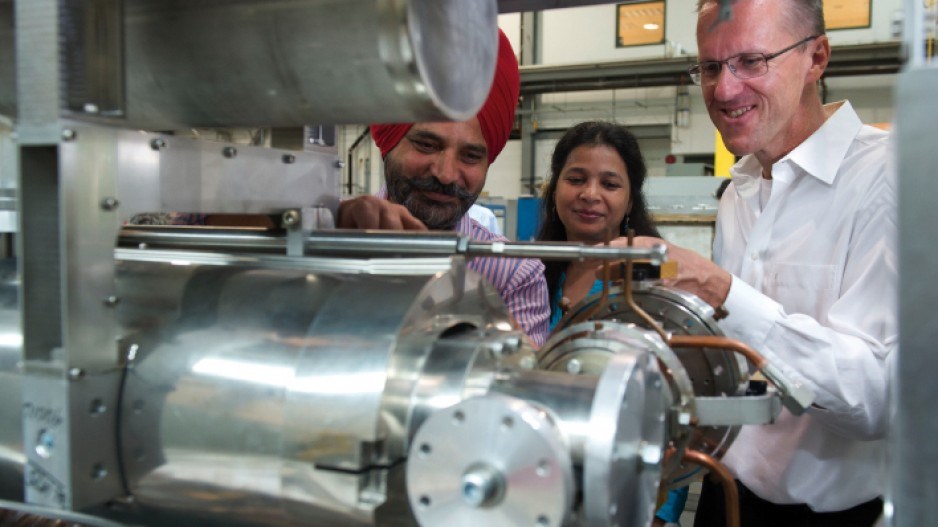In 2005, when TRIUMF labs was looking for an engineering firm capable of building superconductors for a new particle accelerator, it took a chance on a small 20-person company based in Richmond that builds electron beam technology.
E-beams accelerate and concentrate electrons, something like a laser, for precision welding, drilling and coating of metals.
Pavac Industries Inc. was handed a $100,000 contract to use its e-beam expertise to build doughnut-shaped superconducting radiofrequency (SRF) cavities made from niobium for a new particle accelerator.
The combination of their shape, their composition (niobium, a soft metal) and cooling them to within two degrees of absolute zero creates a force field of microwaves that concentrates subatomic particles, like electrons or protons.
Strung together, these niobium doughnuts accelerate the particles and focus them on various elements, which create rare radioactive isotopes used in medical imaging and nuclear medicine.
That initial $100,000 contract led to another $640,000 in work with TRIUMF and several other contracts, including a commission to build SRF cavities for the Department of Energy's Fermilab in the U.S. – a deal that led to Pavac opening a U.S. subsidiary in 2011. Pavac has also been selling its original product – e-beam welders – to Indian labs, which will use them to make their own superconducting cavities.
Now, thanks to a $10 million memorandum of understanding (MOU) signed recently between TRIUMF and the Variable Energy Cyclotron Centre (VECC) in India, Pavac will expand its high-tech engineering expertise to building cryomodules.
Cryomodules are machines that use liquid nitrogen and helium to cool the cavities to the point where they become superconductive (i.e. when molecules stop vibrating, metal loses all electrical resistance and cancels out magnetic forces).
Under the MOU, Pavac will build a TRIUMF-designed cryomodule prototype for VECC, a contract worth about $2 million.
Once tested, TRIUMF will hand it over to VECC, which plans to build a particle accelerator similar to TRIUMF's $100 million ARIEL (advanced rare isotope laboratory), which is nearing completion.
For Pavac, it is another foot in the door of a potentially lucrative market in India and China.
"Right now there's a tent and fence," Pavac CEO Ralf Edinger said of the VECC project in India. "Over the next 10, 15 years they want to build that particle accelerator, so they will need a lot of technology. Once we deliver that [first cryomodule], VECC in India needs at least four to six more."
The Pavac-TRIUMF partnership is mutually beneficial, said Lia Merminga, co-lead on the ARIEL project.
"We transfer technology to Canadian industry, and then Canadian industry is in a position to compete internationally for major contracts for other accelerators built elsewhere," she said.
"Eventually, since we'll be transferring TRIUMF-generated IP to this industry, we could envision that TRIUMF will get back some portion of the revenue."
Thanks largely to its work with TRIUMF, Pavac has tripled its headcount since 2005 and now plans to move as it outgrows its Richmond location. Edinger expects the company's headcount to grow to between 100 and 200 employees over the next two or three years. Ultimately, his goal is to build the key components of particle accelerators as a turnkey product – at $50 million to $150 million each – for countries like India and China, where they'll be used for pure research, creating medical isotopes and a new generation of nuclear reactors.
"The long-term goal is – if we can establish ourselves as a supplier for these things – we can later on offer the whole solution," Edinger said.
However, the brass ring – or niobium doughnut – would be getting in on the ground floor of a whole new generation of nuclear power: accelerator driven subcritical (ADS) reactors that use thorium rather than uranium.
India's Raja Ramanna Centre for Advanced Technology plans to build an ADS system and already has a relationship with Pavac, having bought one of its e-beam welders for making niobium superconductor cavities.
Pavac is now designing a superconducting cavity for an ADS lab in China, as well, just to test it out.
"This is an example of where this could go," Merminga said. "If they are happy, they can give the whole contract [to build the cavities] to Pavac. And since TRIUMF will have IP in the whole thing, it will be something for TRIUMF as well."
Don't have a meltdown – try thorium
One of the more promising applications of particle accelerators is their use in a new kind of nuclear power: accelerator driven subcritical (ADS) reactors.
These systems can be used to treat nuclear waste. Powerful particle accelerators produce neutrons that break up the big, highly radioactive atoms, like americium, into elements with shorter radioactive lifespans, which may reduce the problem of disposal and storage.
"By transmuting them to elements that have shorter lifetimes, then you've solved a big part of the problem," Merminga said.
ADS systems can also be used in reactors to generate energy from thorium rather than uranium.
When used in a reactor, thorium – which is abundant, especially in India and China – does not produce weapons-grade plutonium, and the radioactive waste it would produce would have a shorter radioactive lifespan.
It also addresses the problem of meltdowns.
When uranium is bombarded with neutrons, it sets off a chain reaction that, once set in motion, becomes like a fire that can't be put out.
When this chain reaction occurs, it is said to be in a "critical" state, which continues for about three years, until the uranium becomes depleted.
When a nuclear power plant goes down, as it did in Fukushima, the nuclear reaction doesn't stop, and a meltdown can occur.
Using ADS, the fissioning would be subcritical, meaning it would produce nuclear reactions only as long as the accelerator is running. Switch it off and the nuclear reaction stops.
"It's a lot more safe in that regard," Merminga said.




